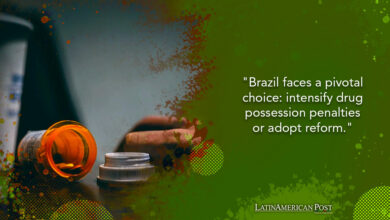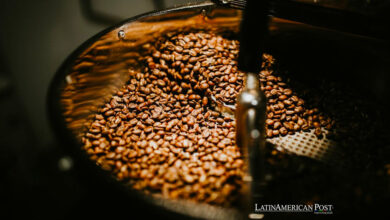To the rhythm of pots, Colombia protested against Duque
'For everything that unites us and against everything that separates us' were some of the phrases that dominated the streets of the main cities of Colombia, during the National strike

Crowd march in Bogotá within the framework of the ‘National Paro 21N’. / Photo: LatinAmerican Post
LatinAmerican Post | Juliana Suárez
Escucha este artículo
Leer en español: Colombia protesta al son de las cacerolas
On Thursday, November 21, Colombia became a scene of protests where hundreds of thousands took to the streets to ask the government for more action and justice.
A bombardment by the Armed Forces, which ended the lives of at least 8 minors, and President Duque's response when asked about this ("What are you talking about, man?"), led the Colombians to streets.
Thursday night, the first day of the National strike that is expected to extend for more days, ended with thousands of people in the streets of the capital banging pots and pans making noise to show the government that they are still there, that they don't shut up and that violent acts are not the ones that sound the most.
Each one from his window, others gathered in the streets and even hundreds of citizens went to the location where the family of President Iván Duque lives, to demonstrate, with the 'cacerolazo', that Colombia is not going to stop until heard.
La Macarena #cacerolazo pic.twitter.com/ZFOrTRn8RZ
— José David López (@mr_free_rider) November 22, 2019
During the day, mainly in Cali and Bogotá, there were some disturbances between the Public Force and people who took advantage of the heat of the protest to commit vandalism and violent acts. But no matter if some tried to overshadow the peaceful protest, the general atmosphere was peaceful.
Dance, music, banners, and colored flags were the protagonists in the peaceful demonstrations in Colombia that gathered dozens of criticisms of the current government and lasted at least eight hours. Singing harangues like 'Without violence', the citizens tried to reject to the maximum the acts of a few that returned the attacks to the ESMAD (Riot Squadron Mobile) or painted buildings or stations of public transport. With human cords formed from young to old, civil society protected the cities from being sown in the streets.
Also read: What you should know about the National strike in Colombia
In the Colombian capital, for example, Carrera séptima and other main routes were taken by students, environmental groups, musicians and indigenous people, among many other groups that marched. Throughout the morning and afternoon, until arriving at the Plaza de Bolivar, the music accompanied hundreds of thousands who wanted to show the government that Colombia is united in peace to ask their rights be respected.
The initial decision of some cities, such as Medellín, was to keep the riot squadrons as there was hope that the demonstrations would be peaceful. In other places, such as Apartadó, police and civilians walked together and the former provided drinks to the latter to hydrate in the middle of the demonstration. In Bucaramanga, until 8pm (Colombia time), the police had reported an environment of total tranquility that had resulted in zero detainees, according to the Police in Caracol News.
Suba, a neighborhood in Bogotá, suffered severe disturbances from early in the morning, citizens gathered with shovels to collect the garbage and the ravages that had remained in the streets.
These are some examples that have given the Colombian people one more reason to join, not only against the government but against those who do not respect the peaceful protest.
Riots
In the light of the cameras, violent acts on the part of both civilians and the Public Force ended up standing out.
Despite the hundreds of thousands who marched peacefully, the end of the day left a distorted image of what was lived on the streets. At the end of the afternoon, some young men stormed outside the building of the Republic Congress in the capital of the country. And the violent events that had been isolated until that moment took the front page of the demonstration. ESMAD dispersed the people of the Plaza de Bolivar, which until then had been completely full, and the first hours of the night were plagued by violent images on social networks.
Citizens set fire to the streets, damaged private property and establishments throughout the country.
The streets of Cali became one of the most violent scenarios that the country has experienced in this type of acts. During the day, the mayor of the city of Cali, Maurice Ermitage, declared a curfew since 7p.m., since there had been a number of riots since the morning. The curfew, which seeks to prevent people from going outside and allows arrests to those who are breaking it, created an atmosphere of chaos that ended up in air bullets and looting homes and shops.
On the other hand, during the night hours arbitrary abuses by the National Police were also reported on social networks. In previous days, Dejusticia had published useful information for civil society in which he warned that the Public Force can only act in reaction to violent acts and in a proportional manner. This was not the case of many events, where young people ended up being affected by walking in the streets, so there would be no curfew, as happened in the city of Bogotá.
Not everything was rosy, but the Colombians have tried to exalt the peaceful acts so that they stand out above the violent facts that are taken in the first planes of the traditional media.
After a long day, Colombia ends with the same uncertainty with which the National strike began. Although thousands of citizens are asking the government for causes related to all sectors of the country, the government has not yet ruled against the requests.
President Iván Duque demonstrated in a speech in which he reproached the acts of vandalism. However, little he said about the requests of Colombian society and the thousands that took to the streets with totally valid orders.
Desde el primer día de Gobierno he sido claro: ni el crimen ni la violencia tienen espacio en nuestra sociedad. Resaltamos la actitud de la ciudadanía que rechazó a los vándalos y dejó claro que para expresarse no se necesita acudir al vandalismo. pic.twitter.com/pDGyg8ZzKd
— Iván Duque (@IvanDuque) November 22, 2019
Given that the Colombian people still do not receive answers, a 'cacerolazo' has been called again this Friday, November 22. In it, the voice of the people and the noise of the pans are expected to be louder than any violent act so that the government must respond for the requests and not against a few who delegitimize the protest.





